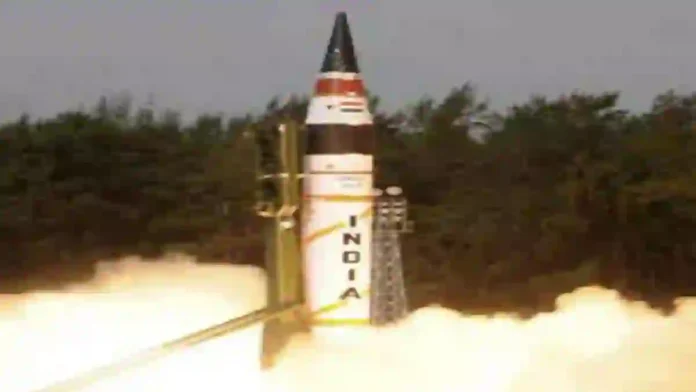India first flight test of indigenously developed Agni-5 missile with Multiple Independently Targetable Re-entry Vehicle (MIRV) technology
Agni-5A/6 MIRV Codenamed “Divyastra” first flight test by DRDO
During the re-entry into the earth’s atmosphere, the topmost part of Agni-V missile gets as hot as 4,000°C. At this temperature, most metals will melt.
A classified material which doesn’t melt at this temperature is used. Also, the material should not conduct this heat inside as the critical components like guidence system may get destroyed. Thanks to the Composite material the temperature inside always remains below 50°C.
Prime Minister Narendra Modi announced the successful test flight of the Agni-5 missile. Prime Minister Narendra Modi announced the successful test flight of the Agni-V missile.
Prime Minister Narendra Modi on Monday announced the successful test flight of the Agni-V missile with Multiple Independently Targetable Re-entry Vehicle (MIRV) technology. “Proud of our DRDO scientists for Mission Divyastra, the first flight test of indigenously developed Agni-5 missile with Multiple Independently Targetable Re-entry Vehicle (MIRV) technology,” he said in a tweet.
Sources said this would ensure that a single missile can deploy multiple warheads at different locations. The project director is a woman and has significant women contribution, sources told ANI.
With the test of Mission Divyastra, India has joined the select group of nations that have MIRV capability. This system is equipped with indigenous Avionics systems and high-accuracy sensor packages, which ensure that the re-entry vehicles reach the target points within the desired accuracy. “The capability is an enunciator of India’s growing technological prowess,” a government source was quoted as saying by ANI.
In the past few years, India has carried out a series of tests of Agni-5. In October 2021, the Ministry of Defence announced the successful launch of the surface-to-surface ballistic missile and said the launch was carried out on October 27 from APJ Abdul Kalam Island, Odisha.
The missile, which uses a three-stage solid-fuelled engine, is capable of striking targets at ranges up to 5,000 kilometres with a very high degree of accuracy. “The successful test of Agni-5 is in line with India’s stated policy to have ‘credible minimum deterrence’ that underpins the commitment to ‘No First Use’.”
What’s MIRV Technology?
A MIRV is a ballistic missile payload designed for Exo-Atmospheric deployment, housing multiple warheads, each capable of targeting distinct objectives. While primarily associated with intercontinental ballistic missiles equipped with thermonuclear warheads, the concept extends beyond strict limitations. An intermediate variant, the Multiple Re-entry Vehicle (MRV) missile, disperses multiple warheads without individual targeting.
What Are The Benefits of MIRV Tech?
Deployment of MIRV can enhance first-strike proficiency for strategic forces and also provide greater target damage for a given thermonuclear weapon payload. Moreover, as it can release multiple warheads, it serves the purpose of a cluster munition, as it reduces the number of missiles and launch facilities required.
With the MIRV, the effectiveness of an anti-ballistic missile system that relies on intercepting individual warheads is also reduced.
Who Has MIRV Tech?
While India is now a part of the elite club, the countries which boast to possess MIRV include:
USA, UK and France- have MIRV technology on their Submarine-Launched Ballistic Missile (SLBM).
China- has MIRVed on Intercontinental Ballistic Missile (ICBM)
Russia- has both MIRVed ICBMs and SLBMs.
Pakistan is also believed to be experimenting with MIRV technology. Though, many experts believe it is only a bluster to keep India on its track. PM Modi has shown gumption to strike deep into Pakistan without much ado Modi government is normally seen not bound by minority politics which is the hallmark of opposition politics. The opposition parties of India believe that doing any harm to Pakistan would anger its vote block and thus harm their chances to form govts both at the centre and in the states. However, I don’t see why the opposition parties have to support such minority elements if they are concerned about the welfare of an enemy country, which has killed. Pakistan’s bluster arises out of fear of such unprecedented attacks by the Indian govt.
(With Agency Inputs)
Read- ISRO’S CHANDRAYAAN-4 MISSION: TWO ROCKETS, ONE HISTORIC OBJECTIVE




